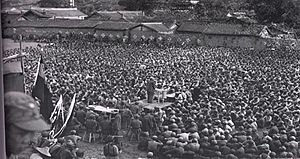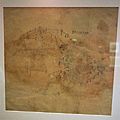Long March facts for kids
The Long March was a huge and difficult journey made by the Communist army in China between 1934 and 1935. Led by Mao Zedong, they had to leave their base because they were being attacked by the Nationalist army, led by Chiang Kai-shek. It was a long retreat, covering about 6,000 miles (or 12,400 kilometers) over 370 days.
Out of about 100,000 to 300,000 people who started, fewer than 10% survived this incredible trek. They climbed mountains over 4,000 meters high and faced many dangers. Even though so many were lost, the survivors became a very strong and dedicated group. This difficult journey helped Mao Zedong become the main leader of the Communists.
Contents
Why the Long March Happened
Before the Long March, China was in a Chinese Civil War. Two main groups, the Nationalists and the Communists, were fighting to control the country. The Nationalists, led by Chiang Kai-shek, had a much larger army.
The Nationalists wanted to get rid of the Communists from their base in Jiangxi province. They had tried and failed four times before. This time, they changed their plan. They used a tactic called "encirclement," which means surrounding the enemy army to stop them from escaping.
The Communist leader, Bo Gu, decided to fight the Nationalist army head-on. However, the Communists only had about 86,000 soldiers, and many of them had only swords, not guns. They couldn't push the Nationalists back. So, they decided their only option was to break through the encirclement and try to meet another Communist army far away in Shaanxi province. This desperate escape became known as the Long March.
How the Long March Changed China
The Long March was a very important event in Chinese history. It allowed the Communist army to survive when they were almost defeated. It also changed how they fought. During the march, the Communists chose Mao Zedong as their main leader. From then on, all the Communist armies in China had to follow his orders.
Mao Zedong believed that the Communists should fight from the countryside using guerrilla warfare. This means using small, surprise attacks instead of big, direct battles. This strategy helped them fight the Nationalists more effectively.
The Long March also had an impact on the Nationalists. As they chased the Communists across China, they fought against local warlords along the way. This helped the Nationalists gain control over more parts of China. However, the chase also meant that the Communist army was greatly weakened. After World War II, the Communists had very few soldiers left. It took them about four years to rebuild their army before they could finally win the civil war against the Nationalists.
Different Views on the March's Outcome
People have different ideas about whether the Long March was a success or a failure.
The Communists believed they won because many of their soldiers survived, and they successfully reached the Communist party in Shaanxi. They saw it as a great achievement to escape from an army of 100,000 soldiers surrounding them and another 200,000 soldiers hunting them during the march.
The Nationalists thought they were successful because the Communists were forced to run away from their base and move to the other side of China. They also killed at least half of the Communist soldiers.
The reason for these different opinions is that both sides had very different goals. The Communists just wanted to survive the Nationalist attack. The Nationalists wanted to destroy the Communist army in Jiangxi and make them weaker. Even though the Communists survived, it took them four years to rebuild their army before they could win the civil war.
Images for kids
-
Tiger Leaping Gorge in the Jade Dragon Snow Mountain massif of western Yunnan province
See also
 In Spanish: Larga Marcha para niños
In Spanish: Larga Marcha para niños





